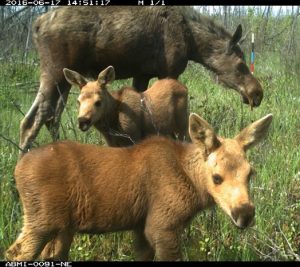Alberta wildlife is ready for its close-up

Two moose calves in Wood Buffalo National Park. Photo credit: Alberta Biodiversity Monitoring Institute (ABMI).
Researchers are using remote cameras and cutting-edge tools to better study and monitor Alberta’s wildlife.
January 26, 2024
Researchers have used remote cameras to monitor wildlife in Alberta for many years, and for good reason: the technology is cost-effective, efficient and safe while enabling researchers to observe multiple species at the same time. However, collecting the data, coordinating with other researchers and reporting information effectively can be challenging.
Alberta’s government is teaming up with researchers to develop new resources and tools that will help wildlife experts work together, study and monitor bears, moose, cougars and other species from miles away.
“We are dedicated to wildlife conservation in Alberta. Led by our Chief Scientist, we are helping researchers better understand how wildlife is behaving and responding to the world around them to help make sure that Alberta’s amazing wildlife continue to grow and thrive for future generations.”Rebecca Schulz, Minister of Environment and Protected Areas
Remote cameras, also referred to as wildlife cameras or camera traps, are important tools for wildlife conservation. Their footage allows researchers to gain a better understanding of wildlife numbers, behaviours and ways to support conservation, all while keeping humans at a safe distance from the action.
The use of remote cameras by Alberta researchers, agencies, industry and the public has been steadily increasing. Alberta’s government and the Alberta Biodiversity Monitoring Institute (ABMI) have helped distribute remote cameras to every corner of the province, from the boreal forest in the north to the grasslands in the south, tracking more than 2,500 species.
Through a $66,000 grant by the Office of the Chief Scientist in 2022, Alberta Environment and Protected Areas, ABMI and the University of Alberta developed new remote camera standards and best practice resources, as well as training materials and tools for wildlife monitoring. As part of this project, Alberta released new remote camera survey guidelines and standards to help improve research, data collection and reporting. This work also improved Alberta’s understanding of what remote cameras are capturing, leading researchers to adjust the cameras and get a clearer picture of wildlife conditions.
This year, another $70,000 in government funding will go towards creating a new online tool to help researchers design remote camera projects, gather data and analyze it. With remote cameras placed throughout the province, this new online tool will help Alberta’s wildlife monitoring projects streamline and coordinate their efforts, regardless of their location, leading to better research.
“The Office of the Chief Scientist is proud to support research and guidance on use of cutting-edge technology to help improve monitoring of provincial wildlife populations. This work will produce results to support the management and conservation of mammals and other wildlife species in the province.”Jonathan Thompson, chief scientist of Alberta
“Alberta collects a vast amount of data using remote wildlife cameras. The funds provided by the chief scientist’s office will help us develop analysis frameworks that make the work done by individual organizations more consistent, repeatable and transparent. It also will help us better approaches for sharing data that drastically improve our ability to measure and manage at broad scales the species and ecosystems that we treasure.”Erin Bayne, professor, University of Alberta, and co-director, Alberta Biodiversity Monitoring Institute
“The implications for data compatibility are huge: the more the standards are adopted by remote camera users, the larger the pool of data available to answer bigger and broader questions about wildlife. The Alberta remote camera steering committee is now working to develop accessible tools to support all users, from new to experienced users, in designing remote camera projects, data analysis and modelling. This will help more people conduct effective wildlife camera research and monitoring while also increasing the amount of data available to all.”Corrina Copp, information centre director, Alberta Biodiversity Monitoring Institute
Quick facts
- The Office of the Chief Scientist coordinates the delivery of an environmental science program to provide scientifically rigorous data, information and reporting on the condition of Alberta’s environment.
- Grants through the Office of the Chief Scientist support evidence-informed decisions on programs and policies addressing Alberta’s natural resources.
- Remote cameras are most often used to monitor medium to larger mammals like white-tailed deer and bears but can also capture images of smaller creatures like birds and amphibians. They are also used to monitor elusive and far-ranging predators like wolverines and cougars.
- Typically, the camouflaged camera is mounted to a tree or post. Some are programmed to trigger when movement or a change in heat is detected in their field of view, while others are activated by a timer. The camera collects data on all species that pass by and stamps the video or picture with the date and time.
- The chief scientist and the Alberta government are committed to supporting research and delivering accessible reporting on the condition of Alberta’s environment.
